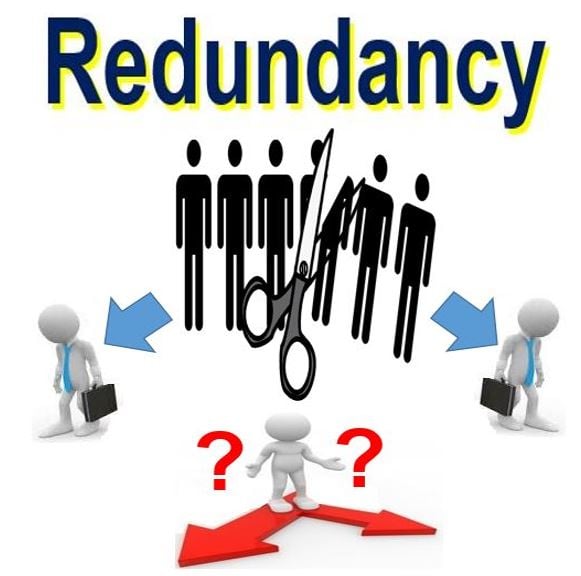If a Company Goes Bust Who Pays Redundancy? Lawful Insights for UK Worker
If a Company Goes Bust Who Pays Redundancy? Lawful Insights for UK Worker
Blog Article
Checking Out the Operational Characteristics of Business Redundancy and Its Long-Term Sustainability

Redundancy Approaches for Service Continuity
In order to ensure undisturbed procedures, businesses have to carry out efficient redundancy methods for service connection. Redundancy in this context describes the duplication of important parts or features within a system to minimize the effect of prospective failings. By incorporating redundancy methods, organizations can enhance their strength versus disruptions created by various aspects such as natural calamities, devices failures, or cyber-attacks.
One usual redundancy strategy is the implementation of backup systems and information storage space options. This entails creating matches of essential information and systems that can be activated in case of a main system failure. Furthermore, organizations can develop redundant interaction channels and power resources to maintain connection and operations throughout unanticipated events.
Furthermore, cross-training workers to do several functions within the business can function as a valuable redundancy strategy. This ensures that necessary tasks can still be brought out also if key personnel are not available because of ailment or various other factors. On the whole, efficient redundancy approaches are necessary for companies to copyright operational continuity and reduce the effect of potential disturbances.
Influence of Redundancy on Business Resilience
Given the critical duty redundancy strategies play in making certain business connection, discovering the effect of redundancy on business resilience comes to be vital for comprehending the all natural operational dynamics of a business. Business strength describes an entity's capability to adjust to disturbances, recuperate from troubles, and change when needed while preserving core features. Redundancy, when tactically applied, can substantially contribute to enhancing an organization's strength in the face of unforeseen obstacles. By having backup systems, employees, or processes in location, companies can much better withstand shocks and proceed procedures with marginal disturbance.
Additionally, redundancy can boost staff member morale and confidence, understanding that there are contingency plans in position to attend to unanticipated conditions. This feeling of safety can result in increased performance and a more positive job atmosphere. Additionally, redundancy can cultivate advancement and creativity within an organization as workers really feel encouraged to take calculated risks, understanding that there is a safety net to support them in situation of failure. In general, the influence of redundancy on business resilience is extensive, shaping the long-term sustainability and success of a company.
Balancing Performance and Versatility in Redundancy
Accomplishing a harmonious stability between functional performance and adaptive flexibility is an essential challenge in the strategic implementation of redundancy within companies. Reliable operations are crucial for preserving productivity and cost-effectiveness, guaranteeing that resources are used efficiently. Nevertheless, too much emphasis on performance alone can cause rigidity, making it hard for companies to adapt to unpredicted adjustments or obstacles. On the various other hand, flexibility enables companies to respond nimbly to progressing circumstances, promoting technology and resilience. Yet, way too much flexibility without a solid functional structure can result in web ineffectiveness and disparity.
To balance performance and adaptability in redundancy planning, organizations have to meticulously examine their operational needs, market characteristics, and critical goals. Ultimately, finding the ideal equilibrium between performance and flexibility is vital for developing why not try these out a resistant and sustainable organization in the face of uncertainty.
Long-Term Sustainability Through Redundancy Preparation
To ensure long-lasting practicality and stability, organizations have to purposefully straighten their redundancy preparation with lasting sustainability objectives, therefore integrating functional performance with flexible versatility. Lasting sustainability with redundancy preparation entails greater than simply temporary cost-cutting measures. It needs a comprehensive critical method that expects future obstacles and opportunities. Business must see redundancy not as a responsive service to instant troubles however as a proactive method for long-term success. By integrating redundancy planning with sustainability purposes, organizations can develop a resilient framework that can stand up to numerous market variations and interior changes.

Positive Steps for Sustainable Firm Operations
Exactly how can business proactively improve their functional sustainability for lasting success? Carrying out proactive steps is crucial for companies aiming to make sure sustainable procedures. One vital technique is to invest in technology and development to simplify procedures, lower waste, and remain affordable in the market. Adopting sustainable practices such as decreasing energy usage, lessening carbon impact, and maximizing source application can not just profit the setting but also lead to cost savings in the future.
Furthermore, cultivating a society of constant improvement and learning within the company can boost versatility to changing market conditions and consumer demands. Encouraging staff member participation in decision-making processes and offering opportunities for specialist growth can increase morale, performance, and general performance. Developing clear goals, keeping track of key efficiency indicators, and frequently evaluating progression are important components of positive sustainability management.
Teaming up with providers, consumers, and other stakeholders to advertise sustainable techniques throughout the supply chain can produce a surge impact of click here for more info favorable effect - redundancy pay if company goes bust. By taking proactive actions in the direction of operational sustainability, firms can develop strength, drive advancement, and secure their long-lasting success in an ever-evolving business landscape
Final Thought

In the realm of business administration, the strategic release of business redundancy stands as a crucial yet complex technique that necessitates a fragile balance in between operational performance and long-lasting viability. By exploring the operational dynamics that underpin firm redundancy and examining its broader ramifications for business durability and flexibility, a nuanced understanding of how redundancy approaches can shape the future trajectory of a business begins to unfold.Offered the crucial duty redundancy strategies play in making sure company continuity, checking out the impact of redundancy on organizational strength comes to be essential for understanding the alternative functional characteristics of a company. On the whole, the effect of redundancy on organizational resilience is profound, shaping the lasting sustainability and success of a business.
In verdict, understanding the operational dynamics of business redundancy is crucial for making sure lasting sustainability.
Report this page